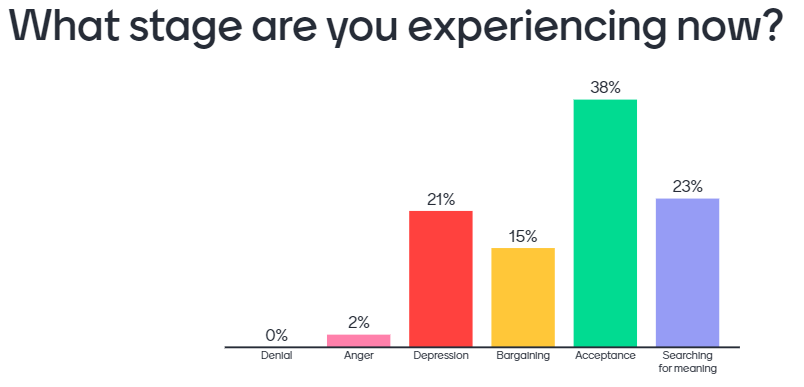Waking up and putting on a smile at work is a deep struggle for many. It is no longer possible to separate our personal from our professional identities while working from home and living under social-political unrest, economic downturn, and a health crisis. This was evident when I asked a client during a coaching session to describe in one-word her emotional state. She fought tears and said, “overwhelmed.” She was visibly at a breaking point.
This experienced let me wondering how others were coping. So during a subsequent training on resilience, I asked employees to identify how they were feeling using the Kubler-Ross Grief Model. See the image below.

The results were not surprising, employees expressed feeling overworked and unable to set boundaries. Some admitted feeling distracted and avoiding dealing with the virus by throwing themselves into a 24/7 work schedule. I asked if any have taken advantage of the paid-leave of absence offered by their employers, the response was “no”. As I further dig for a reason, they expressed concerned with being the target of layoffs and said, no-one in their team has taken it, so they didn’t feel that they should.
A Few Truths
One confessed she was struggling to be productive because she was used to walking into coworker’s offices to gather information & the work from home policy was making it impossible. She was also feeling stress after hearing that a co-worker had committed suicide the previous week and didn’t know how to respond to the matter.
To further explore the psychological landscape, I decided to look at google searches to get a better view of what people are experiencing and the potential repercussions for organizational life. In the last few weeks, the terms “coronavirus anxiety” “coronavirus depression”, “coronavirus suicide”, over-the-counter anti-anxiety medications, “Protests” and “wine near me” are trending in U.S. google searches.
Is this a sign that people are coping with stress by self-medicating or drinking? The data coming from Washington, King county public health department indicate this may be the case as it reported a 21% increase in substance overdose in 2020 first quarter compared to the same time in 2019.
It’s quite alarming to think that people prefer to self-medicate than to take advantage of the benefits offered by organizations. But the reality is that employees are caught in very complex dynamics; where overworking is rewarded, self-care is seen as a burden, & the fear of losing their livelihood outweighs their need for self-care.
Right now, organizations are benefiting from over productivity, which will be short-lived as employees without adequate support will suffer from burnout and struggle longer with depression, grief, and anxiety. This is a concern for leaders like Satya Nadella, Microsoft’s CEO who recently stated to the NY Times that he was worry about employee burnout & mental health.
Are organizations responsible for helping employees improve their health?
Short answer, yes, it’s in their best interest to have well-functioning individuals that can produce at a higher level. Over the years, HR executives have launched well-being programs aim at reducing health care costs. And, diversity and inclusion efforts have shined a light on the stigmatization that employees suffered in the workplace. Unfortunately, none of these efforts have been enough to significantly improve mental health outcomes. Reasons for this abound, Chief Diversity officers are ill-equipped to tackle the issue effectively, employees distrust HR departments, and many organizational cultures focus on high productivity at all costs, including human cost.
Nevertheless, I believe that it is time for CEOs to actively take responsibility for mitigating the impact that stress has on people’s mental and physical health and make it a priority in their organizational strategy. It’s time that their efforts move from merely providing a good employee experience to a real focus on improving employees’ quality of life.
WHY focus on quality of life?
Employees are coming to work to improve their quality of life which includes their physical, mental & financial health, not just to have a good experience.
What You Need To Know
As the world collectively grieves through Covid-19, leaders must expect upcoming high levels of depression, anxiety, and a possible increase in suicide rates in the 45-54-year-old population. See below current rates.

It will be crucial to support the workforce to remain resilient through these traumatic times, by providing them with education about mental health, burnout, suicide prevention & more importantly rewarding them for taking care of themselves. This endeavor requires hiring a Chief Health Officer to move in the right direction & demonstrate that employee’s health matters as much as their productivity levels.
This person’s top competencies will be:
- Program development: Ability to develop and implement mental health programs across organizational & regional boundaries
- Counseling skills: Experience counseling diverse populations with specialization in substance abuse and applying an equity lens to understand social determinants of health
- Collaboration: Engage in collaboration, teamwork, and relationship-building to optimize organizational effectiveness and employee job satisfaction.
- Policy development: Assess and develop policies that support the health & wellbeing of employees.
A few companies have already moved in this direction creating staff roles focus on mental health. A great example is British Telecom, which in 2012 added employee health and well-being as a key strategy for their health and safety policy. To support their goals, the company runs a program to help employees who become ill or disabled transition into a new role. Also, it created a mental health toolkit, a stress risk assessment, and trained 5000 managers in mental health support.
I envision that high performing organizations will make this role an integral part of their C-suite. Let’s hope that after all the trauma experienced thanks to COVID-19, the silver lighting is that organizations recognize the benefits of taking responsibility for protecting the well-being of their employees.
References:
Book: Dying for a Paycheck, Jeffrey Pffeffer.


